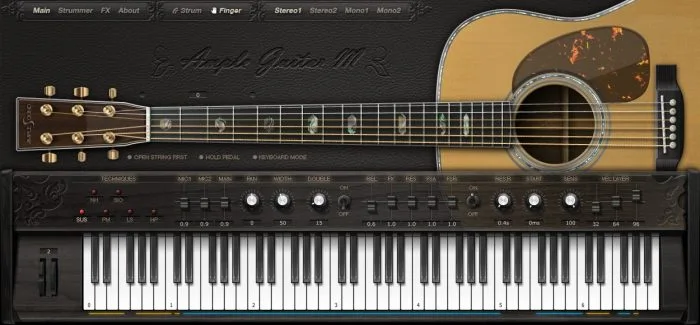Only about a year after Ample Sound first launched, it has already managed to produce no less than 5 virtual guitar instrument libraries. After doing a set of three electric guitars (Fender Strat, Gibson Les Paul & PRS Artist) they have recently released Martin and Taylor acoustic guitar libraries.
The audio demos of these acoustic demos impressed me so much, that I had to check one of these virtual guitars.
My favorite Ample Sound library is the Ample Guitar M, which brings the sound of the Martin D-41 dreadnought to your computer. This one sounds a lot like the Takamine I use myself, so I was drawn to it immediately.
The instrument is built on a total of 3,842 dry samples in finger and strum playing styles. The Ample Sound engine comes with tons of features that allow you to make it sound like you are playing/recording a real guitar. There are various playing styles, fret noise, resonance control, comprehensive chords and strumming, various stereo & mono modes and doubling, and lots more.
So what does it sound like?
Now I don’t know about you, but this gets me all excited about using the AGM instrument in my projects. But there’s a catch… A fantastic demonstration like the one above typically leaves you scratching your head once you load the virtual instrument in your DAW, wondering how the heck they did that. I call this the Jeremy Ellis syndrome.
The AGM can sound incredibly realistic, but it also takes a fair amount of time and effort to learn how to play it. Much like a real guitar I guess. The MIDI programming options are comprehensive, and you will need get familiar with all the settings and controls. You really need to sit down and read the online manual – maybe a few times, since the instrument engine has so much to offer, including small detail type things that will really improve the performance of your guitar tracks.
Ample Sound recognizes that you will likely need some more hands-on training, so they have included MIDI and project files of the demos for some of the major DAWs, so you can see how the tracks were programmed.
If you know how to play guitar you can obviously do some things quite a bit faster on a real guitar (depending on your skills of course), but once you get the hang of the Ample Sound guitar engine, it becomes a great alternative to recording your own parts or session guitarists.
One of the things that took me a while to grasp is the strummer, which includes no less than 28 modes and 14 strum notes, and a library of 15 chord types and a total of 180 preset chords in 3 positions.
In “Select” mode, you can set up 12 chords in the plugin GUI, and use the sequencer to program strumming techniques, and just program single MIDI notes to trigger it all. It is also possible to let the engine “Detect” chords, including inversions for different guitar positions, by using a range of notes.
Typically, realistic guitar strumming is quite hard to do with a virtual instrument, and AMG certainly is not perfect. It can sound a bit lifeless, but again, you have lots of parameters to control detail of the sound (strum time, legato, humanization, etc) and with proper care in your programming you will be able to create authentic results for most strumming modes. Note that all controls of AMG can be automated by MIDI through the CPS (Customized Parameters Setting) system.
It’s worth mentioning the instrument also includes 8 effect unit to further shape the sound; reverb, stereo delay, chorus, phaser, compression, equalizer, overdrive, and wah-wah.
Here’s another demo clip from Ample Sound.
So what do I think?
Format: VST/AU/RTAS/AAX plug-in
Price: $169 USD
Like: Stunning sound, comprehensive, realistic engine
Don’t like: Strummer could be more intuitive
Verdict: 9/10
This virtual guitar is simply amazing. The samples sound crisp to my ears and it has some kind of intimate vibe to it, which I love. I am well impressed with the overall sound and set of features of this instrument.
Ample Sounds’ instrument engine is really powerful. Considering the plethora of keyswitches, playing styles, chords & strumming modes, and whatnot, it does have a bit of a learning curve but it is actually not as hard to get to grips with as you might think. If you take the time to read the manual and check the demo projects, you should be able to create your own guitar tracks soon enough.
In short, Ample Guitar M is an excellent alternative to recording your own guitar parts or using session musicians, and I think it is raising the bar when it comes to realistic virtual acoustic guitar instruments.
Ample Sound has a free Ample Guitar M Lite edition available to download. It has limited features but it is well worth checking out if you want to get a taste of the AGM.
More information: Ample Sound / Ample Guitar M
 Check out ArrangerKing, a plugin designed to help you complete your songs!
Check out ArrangerKing, a plugin designed to help you complete your songs!



